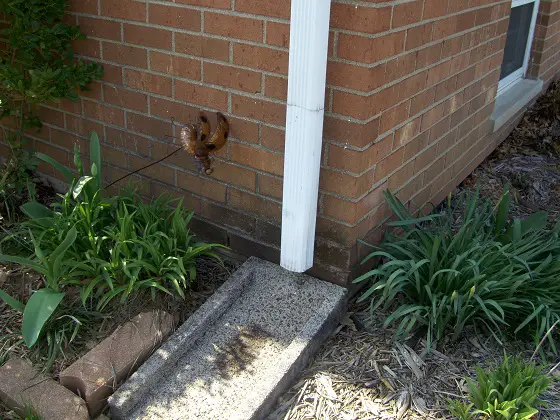Downspout Drainage Solutions
DEAR TIM: My home is less than two months old and I already have a problem with my downspout drainage. Where the sidewalk comes up to my front porch a black corrugated plastic pipe extends through the concrete. The soil under the sidewalk has now eroded and each time it rains I can see water bubble up from under the sidewalk. How can this be fixed and what can be done to prevent foundation damage? Is this poor construction or what do you think caused the problem? Stacie N., Eagle Mountain, UT
DEAR STACIE: Oh my goodness! From what I see in the great photo you sent, you’ve got a problem. Rest assured it can be fixed and the contractor should do it at no additional expense to you.

The downspout drain line under the sidewalk is leaking and causing erosion and possible foundation leakage. Photo Credit: Stacie Noall
Every time I see contractors or homeowners use that flexible corrugated black plastic pipe for downspout drainage, I groan. In my opinion, it’s the least favorable pipe to use. Go back in time and look at old homes and you’ll see that contractors routinely used dense clay pipe for downspout drain lines.
Yes, this was in the day before plastic was invented, but the contractors knew that water should pass through substantial pipes and last generations, not weeks. The clay pipes had their own set of problems in that roots could get into the joints and clog the pipes and if the pipes were not installed perfectly with solid fill under them, they’d crack and collapse.
I’m a fan of plastic downspout drainage lines, but not the flimsy black corrugated plastic. For many years I used a stiff plastic pipe that was rated for sewer lines. It was called SDR-35. That designation may have changed, but while the plastic was not as heavy as schedule 40 PVC, it was somewhat close.
What I liked about this SDR-35 pipe is that the pipe came with self-sealing hubs that had built-in rubber gaskets. The end of one pipe would slide into the wider end of another one and the rubber gaskets provided a leak-proof connection that was also impervious to tree roots.
Don’t confuse this SDR-35 drain pipe with a cheap flimsy white plastic pipe I sometimes see at home centers and big box stores. To get this higher-quality downspout pipe you probably need to visit a plumbing supply house near you that sells products to plumbers.
You’ll be able to purchase fittings that make 90 and 45-degree bends and even other fittings that allow you to connect two pipes into one. These fittings can be glued to the pipe using standard PVC cement and primer. The finished fit is tight and will not leak nor allow roots to enter the pipe.
In your case my guess is the black plastic pipe may have collapsed and cracked very close to the foundation of your home because it was laid over the top of un-compacted fill material that was dumped in next to your home’s foundation. As the ground settled, it put stress on the pipe causing it to either collapse or crack. It’s very important for downspout drain lines to be placed in compacted fill or to be placed in undisturbed soil that’s beyond the hole that was cut into the ground for the foundation.
Here are a few tips to help make sure your downspout drain lines are installed properly and will last generations. The lines need to be installed very much like the plumbing drain lines in your home that might be under a basement slab. The pipes need to slope so they have about 1/4-inch of fall per horizontal foot of run.
If the pipes need to change direction under the soil, never use more than a 45-degree angle. If you need to create a 90-degree bend, then combine two 45-degree bends spaced perhaps a foot apart. Sharp 90-degree bends can be used where a pipe ends near the foundation wall to turn up to capture a metal downspout. The reason you want to use 45-degree bends in all the other locations is they make it easy for a metal drain-cleaning snake to pass through the pipe.
The downspout drain lines need to extend to the lowest part of your lot or at least 50 feet away from your home. You don’t want roof water to exit a downspout and just fall onto a splash block. This amount of water pooling next to your foundation can cause all sorts of foundation issues and leaks into a basement or crawlspace.

Splash blocks don't do much to channel water away from the foundation. © 2017 Roger Henthorn
Some cities or towns require you to connect the downspout drain lines to storm sewers. This is a great idea if they’re available. If not and you live on hilly terrain, you can prevent erosion from the water exiting the pipe by allowing it to flow over larger stone that are about the size of pineapples.
You may be tempted to harvest the rain water coming from the pipes for use in your garden or for some other purpose. Be aware that some states have laws that don’t allow you to do this. Check to make sure what you can or can’t do with the water that falls from the sky.
Finally, do yourself and the future owners of your home a favor. When the trenches are dug for your downspout drain lines take numerous photos of the open trenches with the pipes installed so everyone knows where the pipes are once buried. Print the photos or put them on a flash drive and put these in a labeled waterproof plastic bag stapled to the board next to your circuit breaker panel. You’ll never regret knowing where the pipes are!
Column 1142
3 Responses to Downspout Drainage Solutions